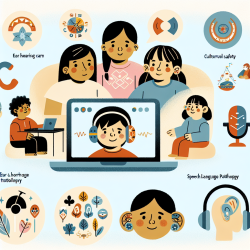Introduction
In the ever-evolving field of speech-language pathology, understanding the intricate connections between mental activity and neural biomarkers is crucial for developing effective therapeutic interventions for children. Recent research, such as the study titled "Mental Activity as the Bridge between Neural Biomarkers and Symptoms of Psychiatric Illness," provides valuable insights that can enhance the skills of practitioners. This blog explores how these findings can be applied to improve child therapy outcomes.
The Triangular Relationship: Symptoms, Mental Activity, and Neural Signatures
The study emphasizes the importance of investigating the triangular relationship between psychiatric symptoms, mental activity, and neural activity signatures. By understanding how these elements interact, practitioners can develop more targeted and effective treatment strategies. This approach is particularly relevant in child therapy, where early intervention can significantly impact developmental outcomes.
Practical Applications in Child Therapy
For speech-language pathologists working with children, integrating these research findings into practice can lead to more personalized and effective interventions. Here are some ways to apply these insights:
- Symptom-Specific Interventions: Focus on specific symptoms rather than broad diagnostic categories. This allows for more precise targeting of interventions, addressing the unique needs of each child.
- Non-Invasive Brain Stimulation (NIBS): Utilize techniques like transcranial magnetic stimulation (TMS) to modulate neural activity patterns associated with specific symptoms. This can enhance the effectiveness of traditional therapeutic approaches.
- Data-Driven Decisions: Use data from neural activity assessments to inform treatment plans, ensuring that interventions are based on objective measures rather than subjective observations.
Encouraging Further Research
While the current research provides a strong foundation, further studies are needed to explore the nuances of how mental activity and neural biomarkers interact in children. Practitioners are encouraged to contribute to this growing body of knowledge by participating in research initiatives and sharing their clinical experiences.
Conclusion
By bridging the gap between mental activity and neural biomarkers, speech-language pathologists can unlock new possibilities for enhancing child therapy outcomes. Embracing a data-driven approach and focusing on specific symptoms will lead to more effective interventions and ultimately, better developmental trajectories for children.
To read the original research paper, please follow this link: Mental Activity as the Bridge between Neural Biomarkers and Symptoms of Psychiatric Illness.










